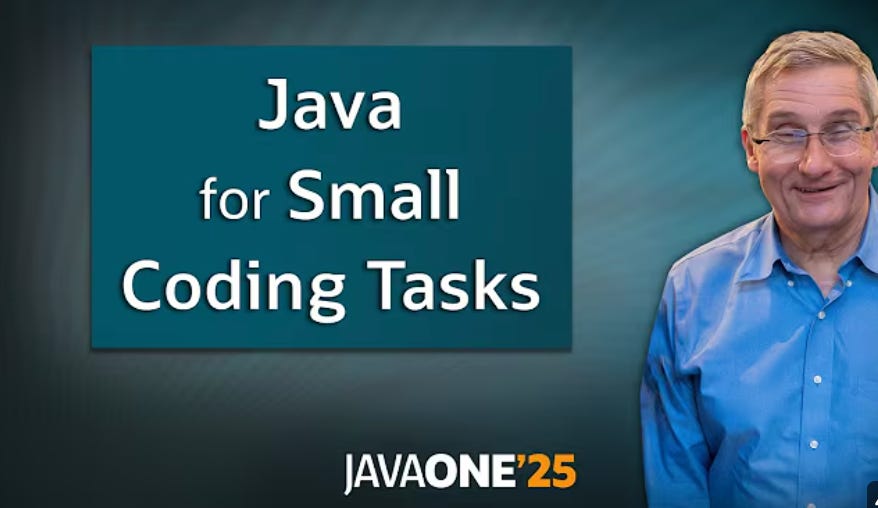Engineering With Java: Digest #61
Java for Small Tasks, Brokk Benchmark for LLMs, Kubernetes Probes in Spring Boot, MgntUtils Stack Trace Filter and more.
Welcome to this week’s edition! I hope you all are having a great time. We have summarized this week’s Java and Spring Boot updates in a 5-minute summary.
We have changed the format of the newsletter, so please feel free to comment if you like or dislike something. Also, we reached 2500 subscribers, so I would like to thank you all for your valuable time ❤️
I would appreciate it if you could recommend this newsletter to your circle with your fellow Java developers.
📝 Articles Of The Week (8)
Filtering Java Stack Traces With MgntUtils Library : Introduces the MgntUtils Java library, which filters stack traces by showing only relevant package lines and collapsing noise into “...”, making logs cleaner and easier to analyze. Developers can configure relevant packages through code, system properties, or environment variables, and use it with both
Throwableobjects and plain stack-trace text.Kubernetes Readiness and Liveness Probes in Spring Boot Apps: Spring Boot’s Actuator module enables Kubernetes to determine application health through readiness probes (which prevent sending traffic to unprepared containers) and liveness probes (which automatically restart unresponsive ones), with customizable settings like path, timing, and failure thresholds.
New Java Benchmark for Coding LLMs puts GPT-5 at the top: Introduces the Brokk Power Ranking—a new, open-source Java-focused coding benchmark featuring 93 real-world tasks—and highlights that GPT-5 outperforms all other models across performance tiers and price points, although it’s notably slower than many competitors.
OpenTelemetry Tracing on the JVM : Compares several zero-code approaches for JVM tracing—like the OpenTelemetry Java Agent, Micrometer Tracing in Spring Boot, the Spring Boot Starter, and Quarkus variants—highlighting their setup differences, trade-offs, and how they capture spans across frameworks
JDK 25 and JDK 26: What We Know So Far : Key features include preview and incubator enhancements like Stable Values (JEP 502), Structured and Scoped Concurrency (JEP 505/506), Vector API (JEP 508), primitive types in patterns (JEP 507), Module Import Declarations (JEP 511), JFR CPU-Time Profiling (JEP 509), compact object headers, ahead-of-time profiling, and the removal of the 32-bit x86 port.
Type-Safe Concurrency in Java: Leveraging Project Loom and Virtual Threads for Modern Applications : Highlights how Java 21’s Project Loom brings lightweight virtual threads, allowing millions of concurrent, blocking-style operations with minimal overhead, while maintaining compatibility with existing APIs like ExecutorService—significantly simplifying scalable concurrency management.
Secure Coding with Java 21: Sealed Classes, Pattern Matching & Crypto Enhancements : Highlights how sealed classes bring clarity and safety by restricting subclassing via
permits, while pattern matching (with enhancedinstanceof, record deconstruction, and switch constructs) reduces boilerplate and promotes expressive, exhaustive logic.Additionally, Java 21 strengthens security with cryptography enhancements, such as default disablement of weak algorithms (via JEP 565) and improved TLS support for safer connections.Data Masking in Spring Boot APIs for Sensitive Fields : Explains how to mask sensitive fields (like credit card numbers or SSNs) in Spring Boot APIs to prevent exposing confidential data to clients. It covers techniques such as customizing JSON serialization to automatically hide or obfuscate these fields, enhancing security and regulatory compliance.
▶️ Videos Of The Week
Java for Small Coding Tasks : Speaker shows that modern Java—with single-file scripts, records, and built-in libraries—is ideal for small tasks, offering stability, type safety, and maintainability. He highlights lightweight scripting features and simple dependency handling without Maven or Gradle.
Java 17: Sealed Classes and Interfaces : aled classes and interfaces let you control which classes can extend or implement them, preventing uncontrolled inheritance. Use
sealed+permitsto list allowed subclasses. Each subclass must be declared asfinal(no further subclass),non-sealed(open for extension), orsealed(restrict further with its own permits).Growing the Java Language : The talk focuses on making Java more growable—designing features that users can extend naturally. Examples like for-each loops and try-with-resources show successful growable features, while proposals like collection literals fail due to rigidity. The goal is consistent, extensible abstractions that behave like built-in language features.
🧑🏻💻 Interview Prep
Spring Interview Questions : Repo is a collection of 500+ Spring Boot and microservices interview questions. It covers core Spring concepts, Spring Boot, Spring MVC, RESTful APIs, annotations, and microservices patterns. Organized with examples and multiple-choice questions, it’s a practical resource for interview prep and learning Spring technologies.
Grokking the Java Interview : eBook designed to help developers prepare efficiently for Java interviews. It covers core Java concepts like OOP, lambdas, and streams, dives into collections and generics, explains concurrency with multithreading and thread safety, and explores JVM internals such as garbage collection and memory management.
Master Hibernate and JPA with Spring Boot in 100 Steps : teaches Hibernate and JPA with Spring Boot, covering entity mapping, relationships, queries, performance optimization, caching, and Spring Data JPA integration, enabling learners to build efficient, robust applications.
📚 Books Of The Week
Java Program Design : Guide for learning Java through object-oriented design. It covers core concepts like inheritance, polymorphism, and encapsulation, and explains design patterns with practical examples.
💬 Social Media Posts Of The Week
This post talks about JUnit 5’s @ClassTemplate that lets you run the same test class in multiple contexts (like locales) without duplicating code. Mark the class with
@ClassTemplateand provide aClassTemplateInvocationContextProviderfor contexts. Unlike@TestTemplate, it reuses the whole class, not individual methods, and works with JUnit 5.13+.This post is curated list of top Java and Spring Boot resources for interview prep or skill sharpening, including 10 essential video tutorials covering multithreading, streams, generics, Spring Boot scenarios, JWT, Redis/MongoDB, and system design, plus 6 informative blogs on Java 9–22+ features, virtual threads, streams, Spring Boot annotations, Actuator, and JWT authentication
🛠️ Code & Tools Of The Week
JobRunr is an open-source Java library for managing background jobs, including fire-and-forget, delayed, scheduled, and recurring tasks using Java 8 lambdas. It supports persistence with SQL or NoSQL databases, distributed execution across JVMs, and provides a dashboard for monitoring. Cluster-friendly and embeddable, it integrates with Spring Boot and is widely adopted in production by companies like Decathlon and Collibra.
Logbook is an open-source Java library designed for transparent HTTP request and response logging across various client- and server-side technologies. It allows developers to log HTTP traffic in a structured format, facilitating tasks such as debugging, auditing, and monitoring
Thanks for making it till the end. If you like this newsletter, please consider subscribing and sharing with your fellow Java developers.
If you like to sponsor this newsletter or have a product that you want to promote please email at: surajmishra150893@gmail.com. Basic details can be found here.
To connect with me, LinkedIn | Twitter. If you have any questions related to SWE/Career, etc, don’t hesitate to DM me. I would love to help my fellow SWEs using my 9 years of experience working in fintech across different countries. ( India/Japan/US/Canada )




In your articles of the week the first article "Filtering Java Stack Traces With MgntUtils Library" which is my article. Thnaks for referencing it.